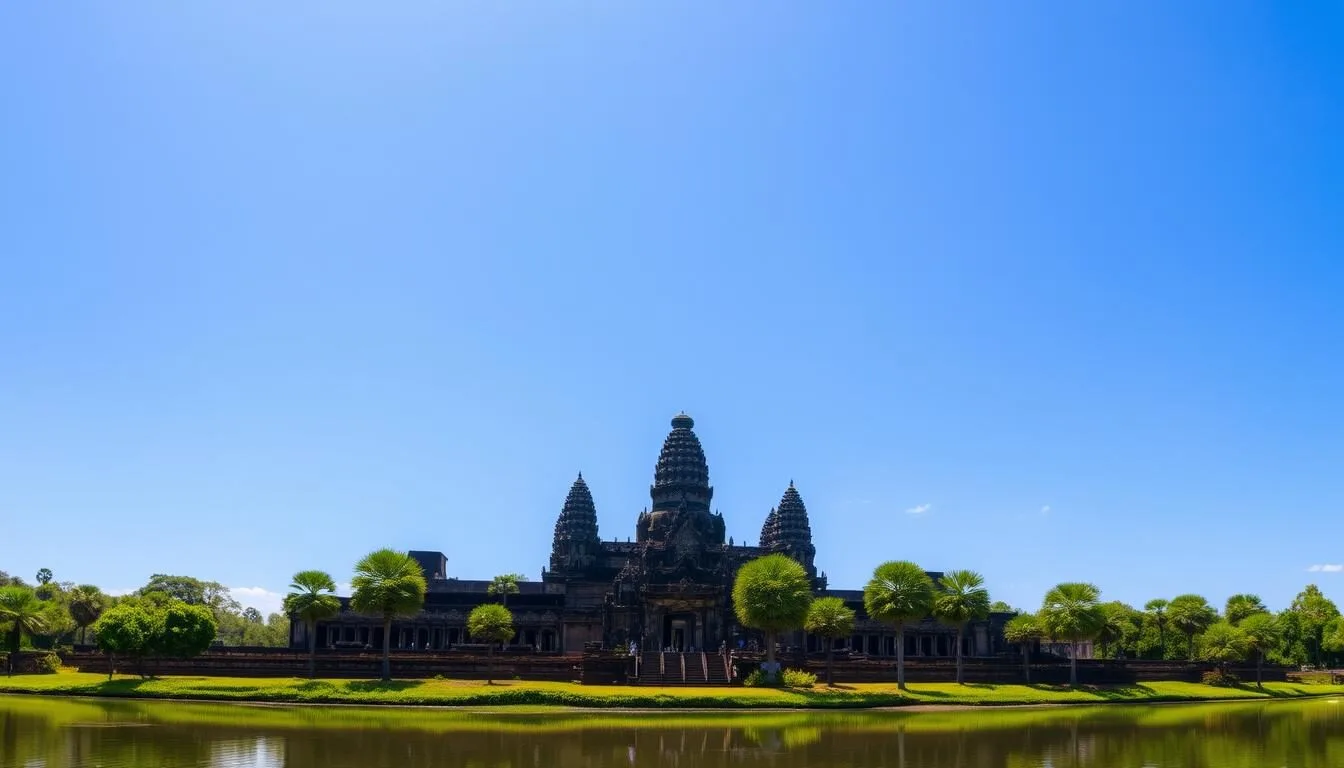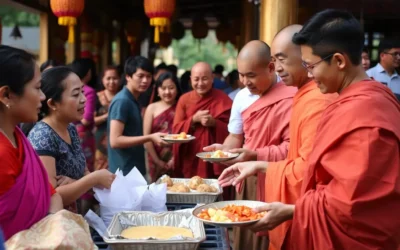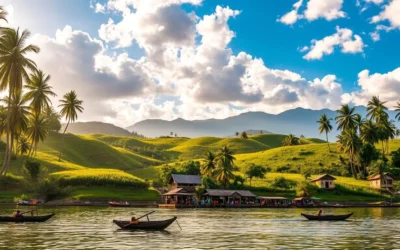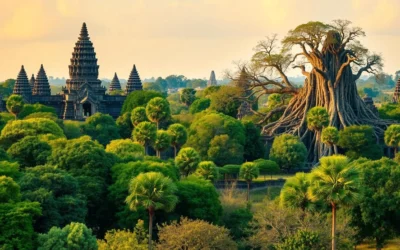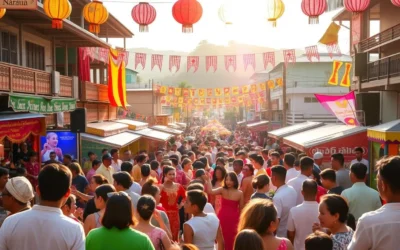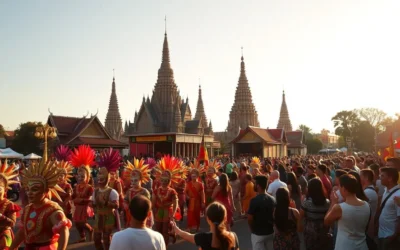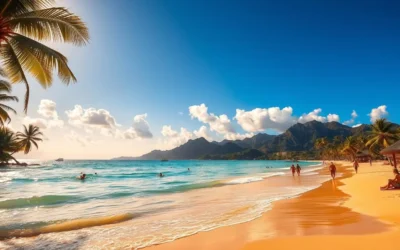✓ Accommodations✓ Flights✓ Rental Cars✓ Tours & Activities
Did you know that Cambodia has just two main climatic seasons: the wet and dry seasons? The dry season, which typically runs from November to March, is considered the ideal time to visit the ancient temple complexes, with comfortable temperatures and minimal rainfall.
Understanding the local weather patterns is crucial to making the most of your trip. By knowing the best time to visit, you can avoid the crowds and enjoy a more serene experience at the temples.
This guide will help you plan a weather-savvy trip to Angkor, ensuring that you make the most of your time exploring this extraordinary UNESCO World Heritage site.
Understanding Cambodia’s Climate Patterns
To make the most of your trip to Cambodia, it’s essential to understand the country’s seasonal weather patterns. Cambodia’s climate is characterized by two distinct seasons: the wet season and the dry season. Each season offers different advantages and challenges for travelers.
The Two Seasons: Wet vs. Dry
The wet season in Cambodia runs from April to October, with the Southwest monsoon bringing frequent rain showers, especially in September. In contrast, the dry season spans from November to April, offering clear skies and sunny days. During the dry season, average highs range from 77°F to 95°F with lower humidity levels, making it more comfortable to explore the temple complexes.
| Season | Months | Weather Characteristics |
|---|---|---|
| Wet Season | April to October | Frequent rain showers, high humidity |
| Dry Season | November to April | Clear skies, sunny days, lower humidity |
Understanding these seasonal patterns will help you pack appropriately and plan daily activities that work with rather than against the weather conditions you’ll encounter. You’ll experience daily rainfall during the wet season, particularly in September, though these showers typically last only about half an hour. Even during the rainy season, mornings are often dry, allowing for early sightseeing before the typical afternoon downpours.
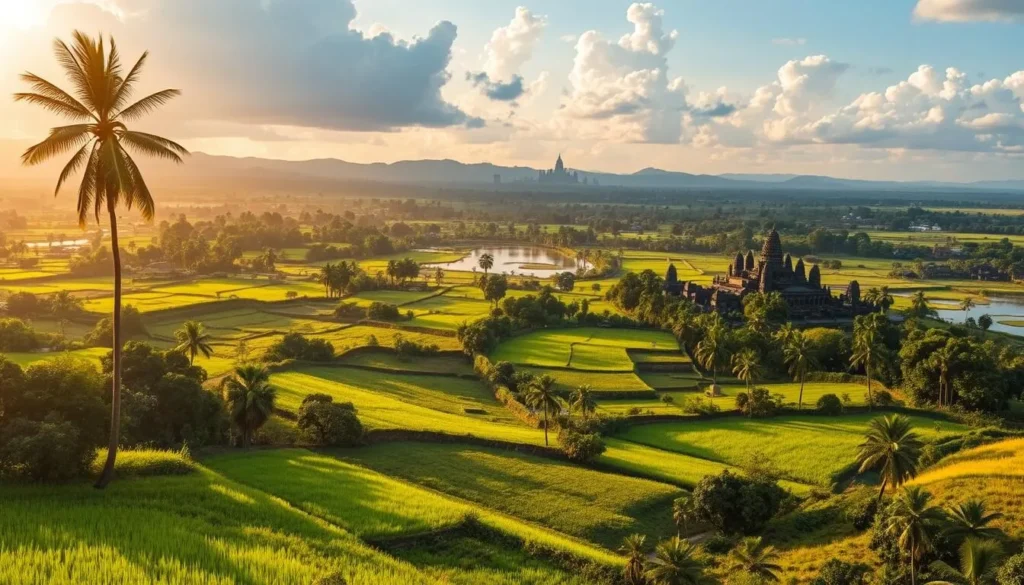
The Dry Season Experience: November to April
The dry season, spanning from November to April, offers ideal conditions for exploring Angkor. You can expect clear skies and minimal rainfall, making it the perfect time to visit the ancient temples without the hindrance of wet weather. The dusty northeast monsoon contributes to the dry conditions, ensuring that the sun shines brightly day after day.
During this period, temperatures are relatively mild, staying in the 70s, which is warm enough to enjoy outdoor activities comfortably. The dry season is considered the peak season for tourists, with December to February being the most popular months. It’s essential to be prepared for larger crowds at popular sites like Angkor Wat, especially around holidays like Christmas and New Year.
Peak Tourist Months: December to February
The months from December to February represent the height of the tourist season. Daytime temperatures range from 77°F to 86°F (25°C to 30°C), making it comfortable for extended outdoor exploration. However, this period also means higher accommodation prices and more crowds at the temple complexes.
| Month | Temperature Range (°F) | Crowd Level |
|---|---|---|
| December | 77-82 | High |
| January | 75-80 | High |
| February | 80-86 | High |
The dry season offers optimal conditions for photography, with clear blue skies providing a stunning backdrop for the ancient temples and monuments. You’ll have a fantastic experience capturing the beauty of Angkor Wat during this time. Be sure to plan your visit accordingly to make the most of your time.
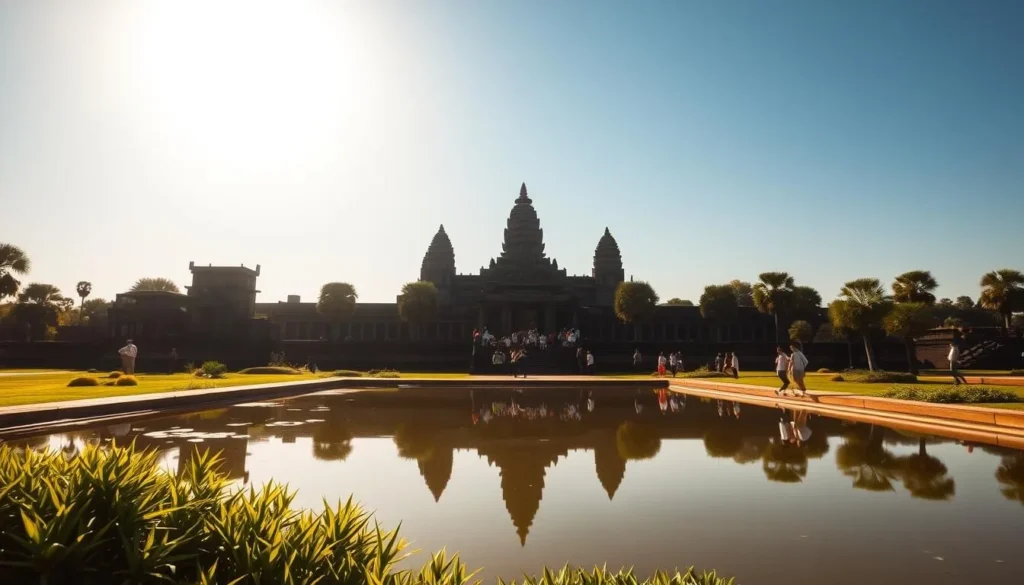
The Wet Season Adventure: May to October
The wet season in Cambodia, which lasts from May to October, is a period of transformation and adventure. During this time, the landscape transforms into lush shades of green, and the temples take on a serene beauty.
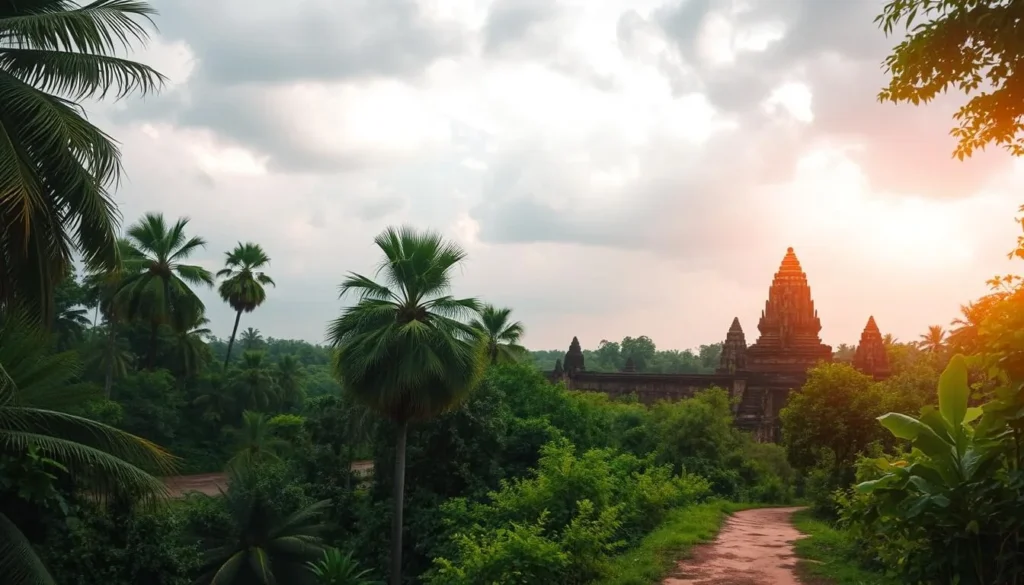
As the southwest monsoon brings regular rainfall, you can expect a different side of Cambodia. While the rain can be heavy at times, particularly peaking in September, it also brings dramatic skies and vibrant landscapes.
Early Monsoon: May to July
During the early monsoon months, from May to July, you can still enjoy many dry hours, especially in the mornings. This allows you to plan your temple visits accordingly, avoiding the heaviest rainfall. You’ll benefit from fewer tourists and lower prices on accommodations and flights, making it an attractive option for budget-conscious travelers.
However, the wet season also brings challenges such as muddy conditions and higher humidity levels, which can make temple exploration more physically demanding. Despite these challenges, many travelers appreciate the wet season for its unique photographic opportunities, such as capturing the temples with reflections in water-filled moats and pools.
Overall, traveling to Angkor during the wet season offers a distinct experience, with lush landscapes and dramatic weather conditions. With proper planning, you can have a rewarding trip even during this time.
Angkor, Cambodia: Best Months for a Weather-Savvy Trip
Cambodia’s Angkor is a destination that demands thoughtful timing for an optimal visit. The region’s climate significantly impacts the quality of your experience, making it crucial to choose the right time to visit.
Optimal Weather Window: November to February
The period from November to February is considered the best time for visiting Angkor. During these months, the weather is characterized by moderate temperatures, lower humidity, and minimal rainfall, creating ideal conditions for exploring the ancient temple complexes.
- November marks the beginning of the dry season, offering pleasant weather and relatively fewer crowds compared to the peak months.
- December and January are the peak months, with optimal weather conditions but larger numbers of visitors.
- February continues to provide excellent weather while seeing a slight decrease in tourist numbers as the peak season winds down.
| Month | Weather Conditions | Crowd Levels |
|---|---|---|
| November | Pleasant, dry | Moderate |
| December | Optimal | High |
| January | Optimal | High |
| February | Excellent | Moderate |
By planning your trip during the optimal weather window, you’ll maximize your comfort while exploring Angkor’s extensive temple complexes. Consider your priorities: perfect weather or fewer crowds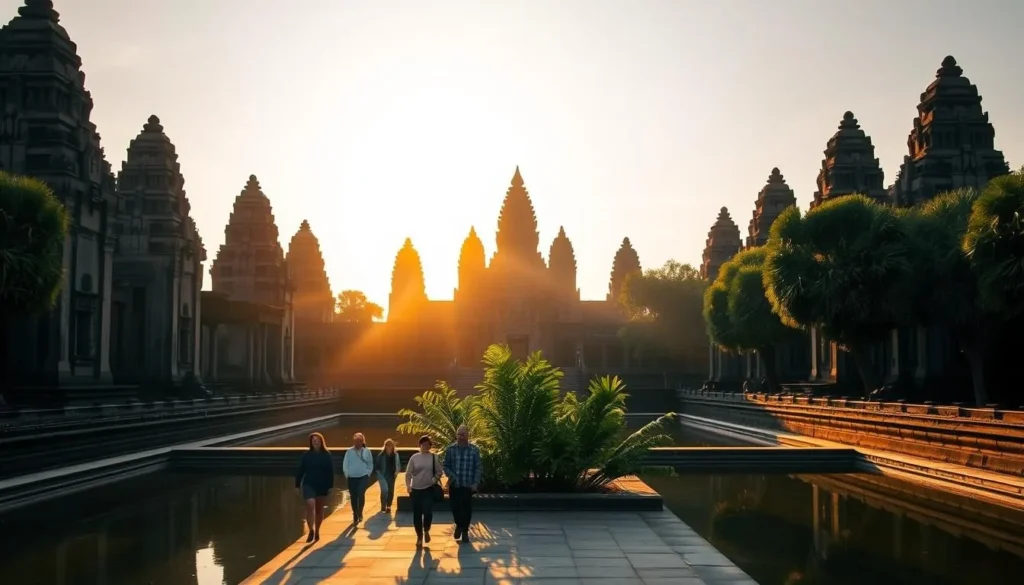
Exploring Angkor Wat and Temple Complexes
Exploring Angkor Wat and its surrounding temple complexes can be a truly enchanting experience. The layout and orientation of Angkor Wat were designed by its 12th-century architects and astronomers based on solar patterns, making it a fascinating destination for visitors.
You’ll want to experience the magical moments of sunrise and sunset at Angkor Wat, when the temple’s astronomical alignments are most evident and the light creates stunning photo opportunities. During the dry season, you’ll have the best chances for clear skies that showcase the temples in golden light.
Sunrise and Sunset Photography Opportunities
The sunrise and sunset at Angkor Wat offer unparalleled photography opportunities. The interplay of light and shadow across the detailed stone surfaces is a treat for any photographer. Consider visiting some of the less famous temples like Banteay Kdei or Banteay Samre during peak hours to avoid the crowds at Angkor Wat, Ta Prohm, or Bayon.
Planning your temple exploration according to the time of day and season will enhance your experience. Early mornings are ideal during hot months, while mid-day exploration is more feasible during the cooler dry season. The temple complexes beyond Angkor Wat offer diverse architectural styles and historical significance.
![]()
Regional Highlights Beyond Angkor Wat
Beyond the majestic Angkor Wat, Siem Reap offers a plethora of activities and attractions to enhance your travel experience. While Angkor Wat is a must-visit destination, the region has much more to offer beyond its ancient temples.
![]()
Siem Reap and Surrounding Attractions
Siem Reap is a town in northwestern Cambodia that serves as a gateway to the mystical Angkor temple complex. You’ll find that Siem Reap offers much more than just access to Angkor Wat, with its vibrant night markets, cultural performances, and culinary experiences that enhance your trip regardless of the season.
- Explore the floating villages on Tonle Sap Lake, which provide a fascinating glimpse into local life, especially during the wet season when the lake expands to five times its dry season size.
- Discover the Cambodian countryside around Siem Reap through activities like bicycle tours, ATV rides, or cooking classes that connect you with local communities and traditions.
- Enjoy the Phare Cambodian Circus, which offers nightly performances combining theater, music, dance, and acrobatics that tell stories of Cambodian culture and history.
Depending on when you visit, you might experience local festivals and celebrations in Siem Reap that provide authentic cultural immersion beyond the archaeological sites, making your travel experience even more memorable.
Practical Tips for Weather-Savvy Travelers
As you prepare for your trip to Angkor Wat, consider the practical tips that will help you stay weather-savvy. Cambodia’s climate can be challenging, but with the right preparation, you can have a comfortable and enjoyable journey.
Packing Essentials for Different Seasons
You’ll need to pack strategically for Cambodia’s climate. Lightweight, breathable clothing is essential year-round, and consider adding items specific to the season of your visit, such as sun protection for the dry season or quick-drying clothes for the wet season.
- For dry season visits, bring high-SPF sunscreen, sunglasses, and a wide-brimmed hat.
- For wet season visits, pack a lightweight rain jacket or poncho, and waterproof footwear.
Staying Comfortable in Heat, Rain, and Humidity
To beat the heat, stay hydrated and take breaks in shaded areas, especially during temple exploration. Opt for moisture-wicking fabrics to combat the humidity, and consider bringing a lightweight rain jacket to be prepared for unexpected rain showers.
![]()
Health Considerations and Precautions
Protecting yourself from mosquitoes, staying hydrated, and being mindful of street food and water sources are crucial to avoiding health issues. Take necessary precautions to ensure a safe and enjoyable trip.
| Season | Packing Essentials | Health Considerations |
|---|---|---|
| Dry Season | Sun protection, lightweight clothing | Stay hydrated, protect against sun exposure |
| Wet Season | Quick-drying clothes, rain jacket, waterproof footwear | Protect against mosquitoes, be mindful of water sources |
Planning Your Perfect Itinerary
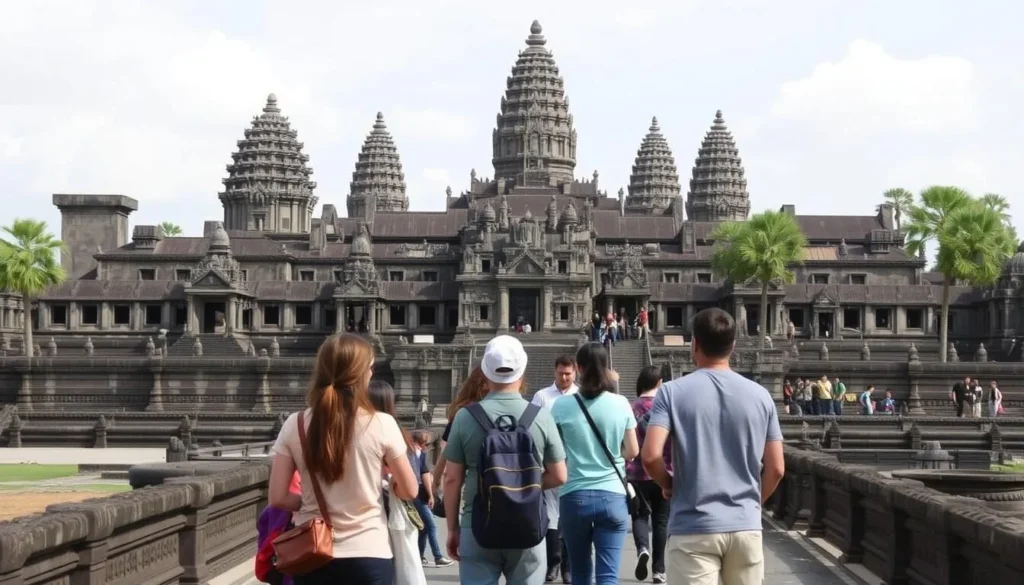
Crafting a personalized itinerary for your Angkor Wat adventure requires insight into the local climate and events. To make the most of your visit, you should align your plans with Cambodia’s seasonal patterns.
Accommodations and Transportation by Season
When planning your trip, consider booking accommodations with pools during the hot season (March-May) to refresh between sightseeing activities. During peak season (December-February), it’s advisable to book your preferred accommodations well in advance. Transportation options like tuk-tuks are enjoyable year-round, but air-conditioned taxis might be preferable during the hottest months.
Cultural Festivals and Special Events
You might want to plan your visit around cultural festivals like the Water Festival in November or Khmer New Year in April. These events offer unique cultural experiences, despite potentially challenging weather conditions. The Water Festival, for instance, signals the end of the rainy season with boat races, fireworks, and street parades, coinciding with cooler and drier weather.
By considering these factors, you can create a well-rounded itinerary that includes temple visits during optimal times and takes advantage of the cultural events that Angkor Wat and Siem Reap have to offer.
Conclusion
As you plan your trip to Angkor Wat, understanding the best time to visit can make all the difference. The dry season, from November to April, offers clear skies and comfortable temperatures, making it ideal for exploring the temple complexes.
You now have a comprehensive understanding of the best months to visit Angkor, Cambodia. November through February provides the most favorable weather conditions for visiting the temples. While the wet season has its challenges, such as afternoon rain and higher humidity, it also offers fewer crowds and lush landscapes.
By balancing your preferences for weather, crowd levels, and travel costs, you can plan a trip that suits your needs. Whether you prioritize photography opportunities, cultural festivals, or budget considerations, you’re now equipped to make informed decisions for a memorable journey to Angkor Wat and beyond.
The above is subject to change.
Check back often to TRAVEL.COM for the latest travel tips and deals.
